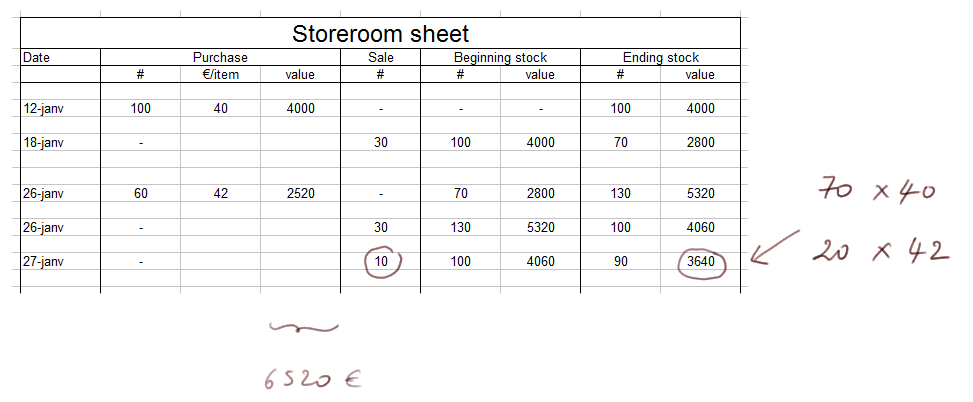General accounting
VII. 28. Methods of stock valuation
Video
We saw that in order to prepare the Income Statement (IS) of a firm over an accounting cycle we must compute the exact Cost Of Goods Sold (COGS) corresponding to the sales.
Usually the COGS is not equal to the Purchases of the cycle. We may have sold more than we purchased, in which case the stock decreased between the beginning and the end of the cycle (this of course is not possible in the first accounting cycle). Or we may have purchased more than we sold, in which case the difference went to increase the stock.
The formula is COGS = Opening stock + Purchases - Closing stock.
Sometimes, it is written: COGS = Purchase - Δ Stock.
Δ means "variation of", that is Ending stock - Beginning stock.
So far in the example we presented life was simple, because the purchasing price of all the items was always the same (40€).

So the calculation of the ongoing and of the final remaining stock posed no problem.
But if the purchasing price of items vary over time, we have to know which ones we sold, and which ones remain in stock.
Sometimes it is more an accounting decision than an actual observation: think of a fuel retailer who buys fuel, puts it in a tank, and sells it. When he sells fuel, it is not possible to say which gallons (at what purchasing price) were sold.
The three main methods to keep track of the COGS and remaining stocks are called:
- FIFO ("first-in-first-out")
- LIFO ("last-in-first-out")
- CWA ("continuous weighted average")
The idea is very simple. Suppose I am a teddy bear retailer. On Nov 6, I buy one teddy bear, which goes into stock. The teddy bear has a purchasing price (for me) of 5€.
Here is my stock (if I had no stock before):

Then, before any sale, on Nov 7, I buy another identical teddy bear, at another purchasing price. Indeed, the prices of my supplier may vary from one date to another. This time I pay 6,5€.
Here is my stock now:


Then, on Nov 8, I sell one teddy bear. (The selling price is, say, 10€, but this selling price plays no role in stock valuation.)
What is the COGS corresponding to this sale?
Well,
- if we use the FIFO method, it is 5€ (this is the price of the "oldest" teddy bear in our stock, that is the one "first in")
- if we use the LIFO method, it is 6,5€
- if we use the CWA method, it is the average value of the current stock, that is 5,75€
and of course the remaining stock is the difference between the COGS and the beginning stock (just before the sale) which was 5 + 6,5 = 11,5€.
To monitor a stock (or a storeroom) the usual sheet is slightly more elaborate than what we presented above.
Here is a usual lay-out:

Let's fill it in with the example of Joe's business. We decide that we shall use the LIFO method.
On Jan 12, we purchase a first batch of items at 40€ apiece:

Then, on Jan 18, we sell 30 items.

(the choice of the method did not play a role yet)
On the 26th, we purchase a second batch of items, at 42€ apiece:

(again, the choice of method doesn't matter yet)
Then, on Jan 26 as well, we sell 30 items. Remember, the selling price doesn't matter for the stock and COGS valuation. But here the choice of method does matter:

In our calculation, we depleted the most recent part of the stock first. This is the meaning of "last in first out".
Finally we make another sale of 10 items.

So at the end of the accounting cycle (assuming Joe's journal, above, covers a whole accounting period), we have the following figures:
- Purchases = 6520€
- Opening stock = 0 (once again, because this was a first cycle; otherwise there would be a beginning figure, equal to the ending stock of the preceding cycle)
- Closing stock = 3640€
- COGS = Purchases - Δ stock = 6520 - [ 3640 - 0 ] = 2880€
Choice of method.
Following the "consistency rule", once we have chosen a method of stock valuation, we must stick to it during all the future cycles.
In some countries the only legal method is the FIFO, while in others we have the choice.
The FIFO method may appear the most logical. Its drawback is that we compute COGS which may not represent current purchasing prices.
When purchasing prices steadily go up, the LIFO method produces the highest COGS figure, therefore the smallest profit before tax, and the smallest income tax to pay.
Exercises:
- Prepare the IS and BS of Joe's business with the LIFO-method figure for the ending stock we just computed.
- Recompute the ending stock using the FIFO method.
- Recompute the ending stock using the CWA method.



